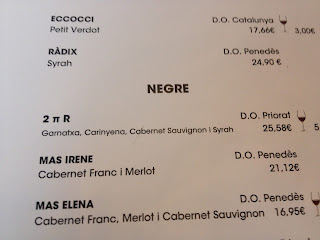I've just had an amazing four-day trip to Barcelona, and of course tasted some delicious wines while I was there...
The fist night I started with a garnacha (grenache) rose. It was a Castillo de Javier from from Navarro region. I was in the restaurant Celler de la Ribera, which had inoffensive food, and this rose was very dry, some raspberry and cherry fruit, but was a little tart.
http://www.tripadvisor.co.uk/Restaurant_Review-g187497-d1945818-Reviews-Celler_de_la_Ribera-Barcelona_Catalonia.html
We wanted to go to La Vinya del Senyor, which I had been to on several previous trips to BCN and know them to serve delicious local wines, but it was far too busy, there wasn't enough room for us to stand.
http://www.lavinyadelsenyor.com/
So instead we went to Bastaix around the corner. They serve Catalan food here, so looked like an interesting menu (not just jamon, manchego, and patatas bravas for the tourists like they serve everywhere else). Our waitress Marina explained Catalan food is much healthier than Spanish food, but tourists rarely get to try it. The wine here is divine. They have several bottles open at a time so you can have a glass of a very good wine, not just "una copa vino tinto" in this restaurant! Our recommendation was to have the Portal by Pinol from Terra Alta (in Catalonia of course!). This wine was amazing, you could tell just by the aromas that this was going to please the palate. Dry, lovely rich black fruits, with a balanced tannin/acidity to give complexity and ensure the lovely flavours stay in your mouth a while longer. This winery uses French, American and Hungarian oak to develop the flavours, using a multitude of varietals - this wine was made of Cabernet Sauvignon, Grenache, Tempranillo, Merlot and Syrah.
http://www.bastaix.com/
On the last night, in Matamala, I had quite a pleasing wine called 2piR from Priorat. As the name suggests, this is intended to be a round wine, and it was indeed a good all rounder - balanced, flavoursome, and easy to drink, probably due to the number of varietals selected for this wine. However, after some of the other delicious wines I had tasted, I felt it was lacking oak depth.
http://www.matamalarestaurant.com/
TIP: When you visit a wine region, be sure to try local wines. The people will be happy to give recommendations, and they will be delighted you want to try local produce. And I don't mean just drink Rioja when you're in Spain, try to find local local wines, like I tried to dig out Catalonian wine in Barcelona. The difficulty will be finding local haunts that will give you the good stuff by the glass.





